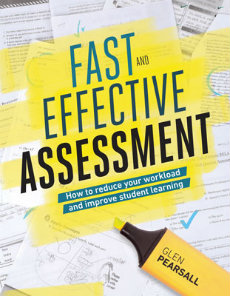Effective Assessment for Improved Learning
Fast and Effective Assessment: How to Reduce Your Workload and Improve Student Learning
By Glen Pearsall
(ASCD, 2018 – Learn more)

Fast and Effective Assessment: How to Reduce Your Workload and Improve Student Learning by Glen Pearsall will be a welcome addition to any teacher’s professional library. Pearsall stays true to the title throughout the book as he focuses on making life easier for teachers while improving students’ learning and understanding.
Each of the six chapters is designed to improve “the quality of feedback your students receive while reducing the time and effort you spend on generating this feedback.” (p.2)

Chapter 1: More Effective Questioning
Chapter 2: Clear Learning Goals
Chapter 3: Checking for Understanding
Chapter 4: Formal Formative Testing
Chapter 5: Sustainable Marking
Chapter 6: Reflection and Third-Stage Correction
Questioning Techniques
Pearsall reminds us that “being more deliberate about questioning can generate better student responses.” (p.6) He suggests that by making changes in questioning techniques, teachers can reduce the amount and frequency of work that needs to be assessed. In Chapter 1 he offers a variety of techniques to increase student participation. What’s really great is that in addition to the technique, he provides examples and suggested adjustments to make it more effective in a variety of content areas.
Readers will find strategies for dealing with wrong answers and for dealing with students who dominate the discussion. He identifies activities that work well with gifted students and with English language learners. Pearsall frequently points out how to differentiate questions to meet the needs of all students.
“Extending thinking time is a particularly effective way to improve your teaching because it takes no extra work and yields good results.” (p.13) The author then offers practical, easy-to-implement strategies designed to offer students more thinking time. Here are three of my favorites:
✻ The Golden Question
In order to understand what students are thinking, Pearsall suggests asking The Golden Question: “What makes you say that?” This question, along with some variations, will get students in the habit of justifying answers. This is a great technique to share in a team- or grade-level meeting since it can be used with almost any content.
✻ Inverted Questions
This strategy will help avoid the “guess what I’m thinking” game that teachers often play with students. In Inverted Questions, the teacher flips the answer into the question stem and asks students to explain why the answer is correct.
✻ Contextual Solicitation
While similar to Inverted Questions, this technique includes a key piece of knowledge before the question. Contextual questions require time to plan, but it will be time well spent since it builds thinking and reasoning skills. Each of these strategies fits nicely into test prep lessons.
Options for Feedback
Chapter 3 is filled with ideas focusing on feedback that is “fast, formative, and frequent.” (p. 65) Pearsall grouped these ideas, techniques, and strategies into six categories: Snapshot Assessments, Short Written Feedback, Preplanned Feedback Questions, Ordering and Ranking, Demonstration, and Accessing Prior Learning. Several of the suggested techniques are “oldies, but goodies” (e.g., Traffic Lights, Fist to Five, Continuums, K-W-L, etc.); however, the author presents some minor but useful adjustments to these to be sure teachers get the information they want.
Pearsall suggests that teachers rethink formative testing practices in order to better assess students’ performance. He includes strategies designed to engage students in deliberative practice. Again, there are numerous activities, and all are useful.
While there is no quick-fix for that stack of papers that need to be scored, there is help; Pearsall offers a 3-step process for marking work.
- Establish quality control (be consistent)
- Identify rapid-correction strategies
- Offer effective feedback.
Tech Tools to Use Now
In his discussion of rapid-correction strategies, I was introduced to Plicker cards and Screencasting. Yes, I stopped reading to explore these technology tools! And, yes, I will be sharing them with others!
So, how do we get students to pay attention to our feedback? Once again, the author offers an abundance of techniques and strategies. For example, instead of spending hours correcting every single error on a student’s paper, he suggests Minimal Marking with focused feedback. Other strategies suggested include Error Flagging, Error Counting, and Double-ticking. The author explains that these are “minimal” in the amount of teacher time; however, students are required to do more or less in response, based on the strategy selected. Be sure students and parents understand what this marking means and how it is used.
Glen Pearsall’s Fast and Effective Assessment: How to Reduce Your Workload and Improve Student Learning offers teachers practical assessment advice…something any teacher can use.
A Study Guide is available from ASCD.
Former eighth grade teacher Anne Anderson is an educational consultant known for her practical ideas and engaging ELA workshops. Anne’s goal is to help teachers help students. Her positive approach and sense of humor bring encouragement to her audiences. She loves showing teachers how to use whatever resources they have – or don’t have – to enhance learning. Anne seeks to provide educators with practical solutions to teaching and learning problems. Visit her website and subscribe to her bi-monthly newsletter, Spotlight on Success, there or by texting ANNEANDERSON to 22828.






























